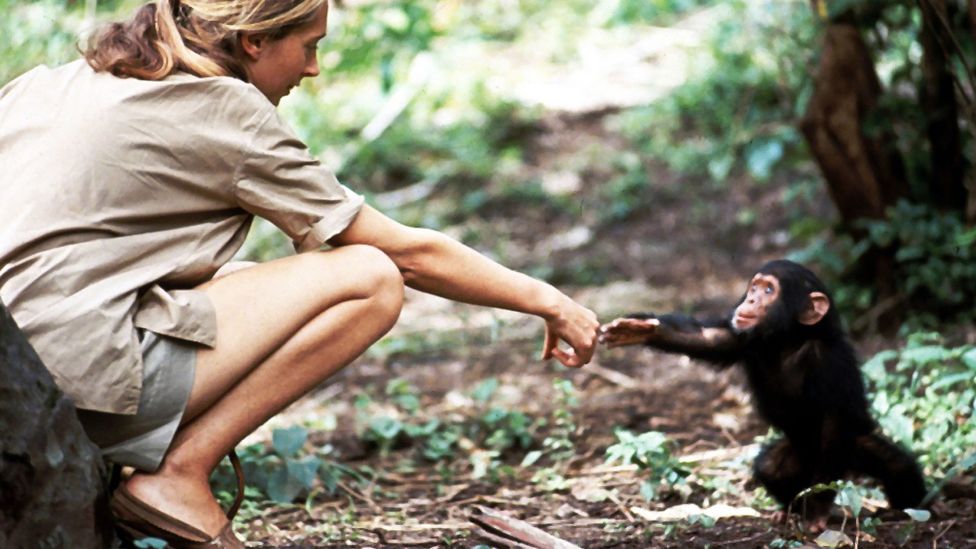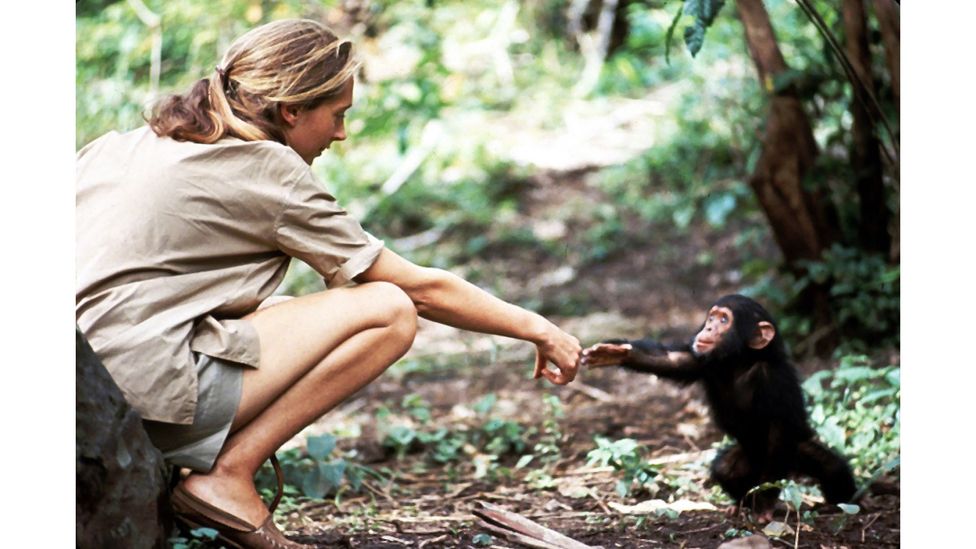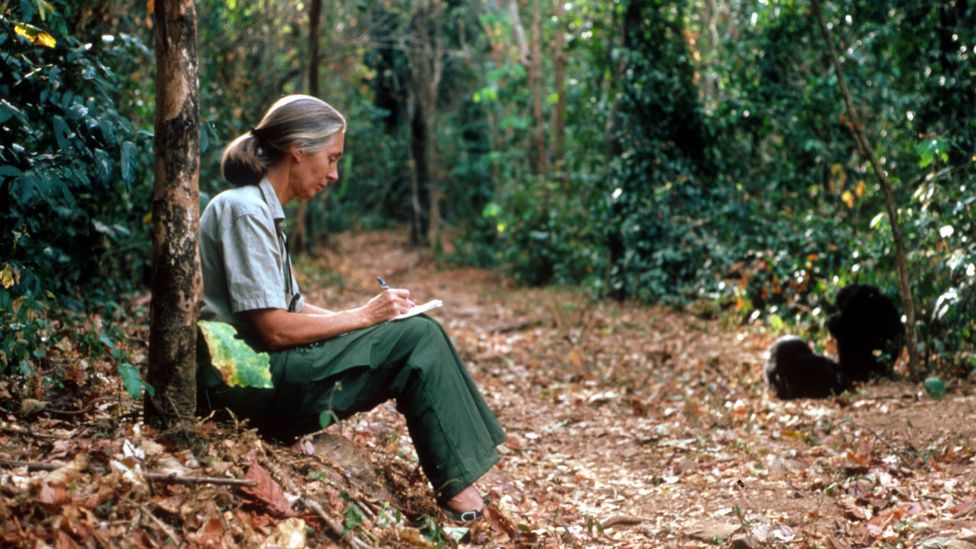
On 14 July 1960, 26-year-old Jane Goodall arrived by boat to the shores of Lake Tanganyika, Tanzania. Here, in what is now Gombe Stream National Park, her ground-breaking scientific research into chimpanzee behaviour began.
Previously a secretarial student without an undergraduate degree in science, Goodall says she observed her wild subjects with an open mind and without preconceptions. Controversially at the time, she defied convention by giving these chimps names instead of numbers.
One image taken of Goodall during this time captured her fresh approach, challenged the scientific norm and has become one of the world's most recognisable photos.
Her late husband, Dutch photographer Hugo van Lawick, went to Gombe in 1962 where he took thousands of photographs of Goodall. But it was in 1964 that he took what became an iconic photograph of Goodall with an infant chimp known as Flint.
In the photo, Goodall is shown crouching down and reaching out with her right arm to Flint, the first chimp to be born at Gombe after Goodall's arrival, as he extends his left arm up towards her.
As Goodall tells BBC Future, this was long before the era of digital photography, so she had to wait a while before she could see the printed images. "It was couple of months or more before there was a safe way to send exposed rolls to the [National] Geographic for processing, and then another wait while they sent the prints back to Kigoma," she recalls. "When I saw it, though I did not realise it would become iconic, it did make me think of Michelangelo's painting of God reaching out to Man."

The photo of Jane Goodall with infant chimp Flint challenged scientific norms and changed our view of the animal kingdom (Credit: Hugo van Lawick)
The photo, taken in 1964, was first published in National Geographic magazine in December 1965. Another photo of Goodall studying the Gombe chimpanzees was on the front cover and published as part of van Lawick's photo series titled "New Discoveries Among Africa's Chimpanzees". That same year, National Geographic released Miss Goodall and the Wild Chimpanzees, the first of many documentaries showcasing Goodall's research.
The photo, along with van Lawick's documentary film People of the Forest: The Chimps of Gombe, "forced science to abandon the idea that humans were the only sentient beings with personalities, minds and emotions" says Goodall, adding that she was taught this as a student at Cambridge University in 1962. "Thus [this image] opened up a whole new way of understanding who animals are and showed that we humans are a part of and not separated from the rest of the animal kingdom."
Goodall was the first person to notice that chimpanzees were stripping down stiff blades of grass, then sticking them into holes in termite mounds to catch and eat these insects. Until then, tool use like this was believed to distinguish humans from all other animals.
You might also like:
- The birds ensnared by plastic
- A 'game changer' for tracking species
- The 1968 photo that changed the world
Mark Wright, director of science at conservation charity WWF, says Goodall was "a real trailblazer" in many ways. But this photograph helped people recognise the importance of a female perspective within the scientific research community, he says. "She was a young woman saying that women are equally well-placed to do really first class research in the field.
"Up until then, it had been a pretty male-dominated environment. There then was a succession of high profile women doing this sort of work."
Gilbert M Grosvenor, former chair of the National Geographic Society, has likewise argued that "Goodall's trailblazing path for other women primatologists is arguably her greatest legacy".
"During the last third of the 20th Century, Dian Fossey, Birute Galdikas, Cheryl Knott, Penny Patterson, and many more women have followed her," he wrote in the Jane Goodall Institute's biography of the primatologist."Indeed, women now dominate long-term primate behavioural studies worldwide." (Read more: The woman who redefined mankind).
Goodall's trailblazing path for other women primatologists is arguably her greatest legacy – Gilbert M Grosvenor
When the photo was taken in 1964, Goodall was immersed in life at Gombe, beginning to understand the chimps she was studying and slowly building up her observations of their behaviour. This first-hand experience has always been her priority, says Wright. "This photo reminded us that for much of this work, there's no alternative to being in the field. A lot of studies were in zoos or safari parks – you need to get in the field to really understand the natural behaviour. And you have to do that for the long-term, you can't just nip in for a couple of weeks. She reinforced that."
Goodall went to East Africa without any formal qualifications and lived in Gombe for more than two decades, dedicating her life to studying chimps for generations. Wright says this photo relays a powerful message to people who haven't studied science but still want to get involved in research because sometimes, an open mind is the best starting point: "This wasn't someone in a lab coat, she made it relatable. And because she wasn't encumbered by lots of formal training, she could go in as a free thinker and then interpret [what she saw]."

Jane Goodall's research into chimps in Tanzania paved the way for other female primatologists (Credit: Penelope Breese / Getty Images)
Keen to open the world of scientific research up to everyone, Goodall has inspired many people to study primatology in the field. Since 1960, more than 482 scientific research papers and graduate theses about chimpanzee health and behaviour have been published by Gombe Stream Research Center, with hundreds of scientists studying there.
Carbon Count
The emissions from travel it took to report this story were 0kg CO2. The digital emissions from this story are an estimated 1.2g to 3.6g CO2 per page view. Find out more about how we calculated this figure here.
Alongside her vast body of documentary films, books and National Geographic articles, Goodall's photographs with Flint flagged the importance of conserving individual animals. "Previously it was all about saving species – individuals were not important. The scientific thinking changed," says Goodall.
A 2021 review by US anthropologist Michael Lawrence Wilson summarises the many findings of research undertaken at Gombe and reflects on the impact of the chimpanzee research efforts pioneered here by Goodall. "Gombe exemplifies what has become a standard approach for primate field studies: collaborative research, collecting systematic information on identified individuals, followed throughout their entire lives," it concludes.
Today this photo makes Goodall feel nostalgic. "It reminds me of a magical time when I knew each individual chimpanzee as well as members of my family. I watched Flint's development from a tiny infant to a spoilt brat, always supported by his older sister or one of his older brothers if another youngster accidentally (or sometimes deliberately!) hurt him. The image makes me think of those best days of my life," she says.
The image reminds me of a magical time when I knew each individual chimpanzee as well as members of my family – Jane Goodall
The closeness between Goodall and Flint in the photograph also reflects the culture at the time, says Wright, noting that scientists now keep further from the animal subjects they are observing. "But she was doing something that hadn't really been done before…I take my hat off to her. Her work was absolutely ground-breaking."
Above all, the picture shows Goodall's genuine love for her subject, Wright says. "There is a warmth and an affection for the species she's studying. There's also a love for Gombe, too – she found her place."
For Goodall, it's her simple connection to Flint that makes this image so captivating. "I suspect it was the appeal of that little infant reaching out so trustingly – a real bond between human and chimpanzee. At least, that is why it is so powerful for me!"
*The Jane Goodall Institute notes that physical contact with wild animals is no longer deemed appropriate and says that it "does not endorse handling, interacting or close proximity to chimpanzees or other wildlife".
--
Aucun commentaire:
Enregistrer un commentaire